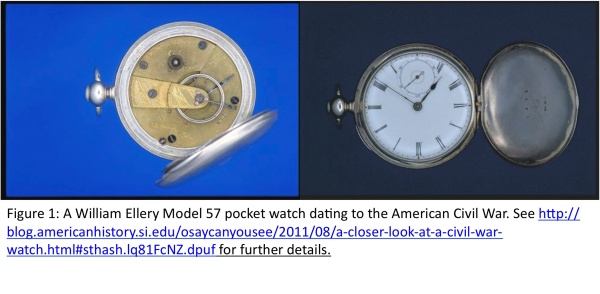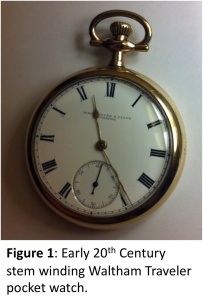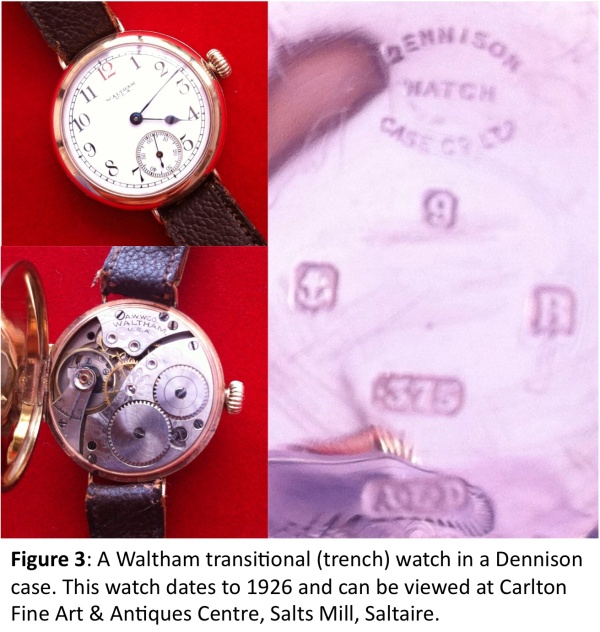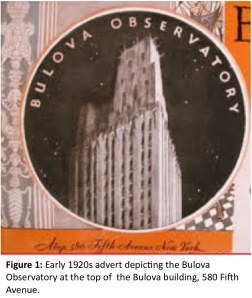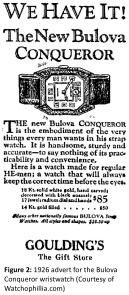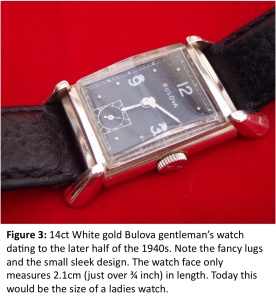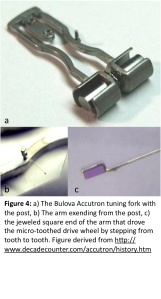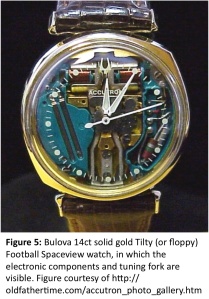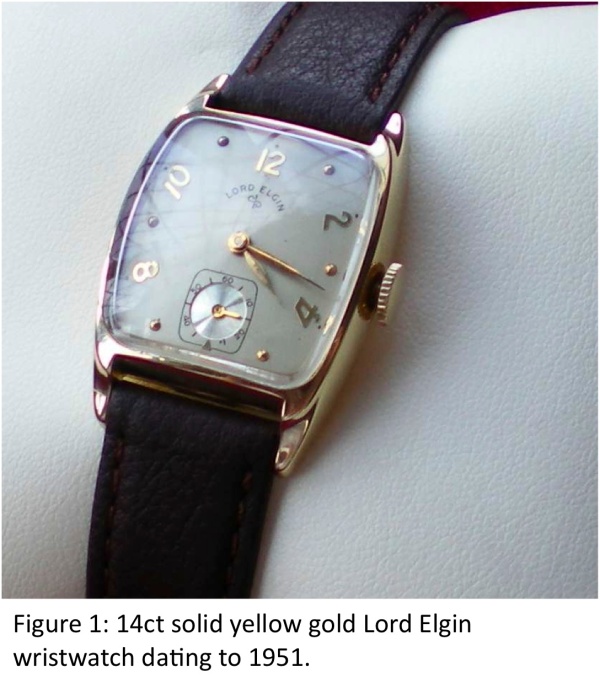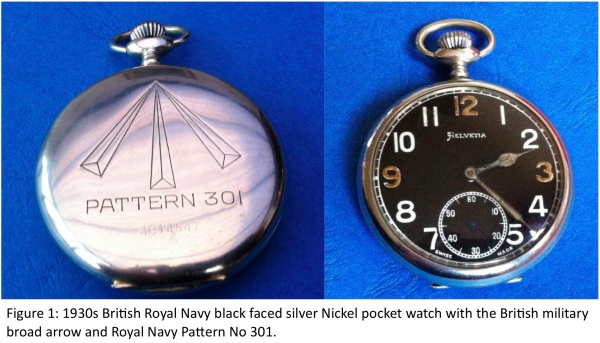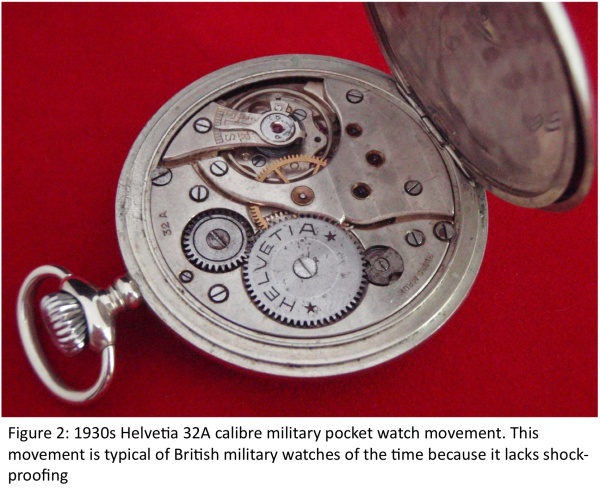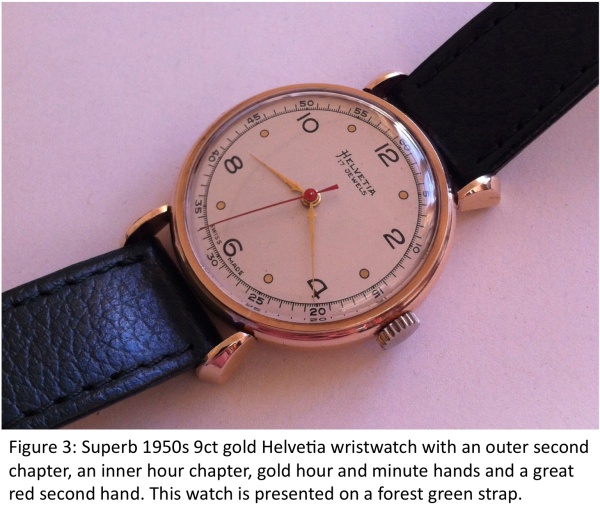By Morgan Denyer
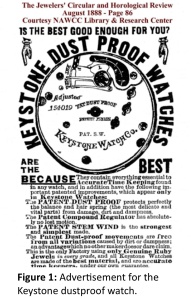 The history of the Hamilton Watch company goes back to 1886 when
The history of the Hamilton Watch company goes back to 1886 when 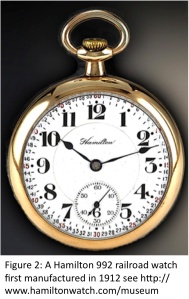 Abram Bitner bought the Lancaster Pennsylvania Watch Company factory to establish the Keystone Standard Watch Company. The keystone Watch company developed a 18-size, 3/4-plate movement, with 15 jewels that incorporated a patented dust-proofing system (Figure 1) and was accurate enough to for use on the railroads. Unfortunately the company struggled and was eventually auctioned at a Sheriffs sale to a group of Pennsylvanian businessmen (J. W. B.Bausman, John F. Brimmer, Harry B. Cochran, Frank P. Coho, C. A. Fondersmith, George M. Franklin, John Sener, John C. Hager, J. F. McCaskey, H. M. North, Martin Ringwalt, J. Frederick Sener, William Z. Sener, James Shand, Peter T. Watt and H. S. Williamson. Charles D. Rood and Henry J. Cain of the Aurora Watch company) following its bankruptcy in 1892. The new company merged with the Aurora Watch Company of Illinois and was given the name The Hamilton Watch Company in honour of James Hamilton, a local and important historical figure who served as an elected member of the Provincial Assembly, was the Mayor in 1745, and was commissioned by the Penn family to function as lieutenant-governor on a number of occasions between 1754 and 1773. James Hamilton also owned large tracts of land granted to him by the Penn family and he used some of that land to build the State House and surrounding public spaces. He has been credited with founding the city of Lancaster, Pennsylvania.
Abram Bitner bought the Lancaster Pennsylvania Watch Company factory to establish the Keystone Standard Watch Company. The keystone Watch company developed a 18-size, 3/4-plate movement, with 15 jewels that incorporated a patented dust-proofing system (Figure 1) and was accurate enough to for use on the railroads. Unfortunately the company struggled and was eventually auctioned at a Sheriffs sale to a group of Pennsylvanian businessmen (J. W. B.Bausman, John F. Brimmer, Harry B. Cochran, Frank P. Coho, C. A. Fondersmith, George M. Franklin, John Sener, John C. Hager, J. F. McCaskey, H. M. North, Martin Ringwalt, J. Frederick Sener, William Z. Sener, James Shand, Peter T. Watt and H. S. Williamson. Charles D. Rood and Henry J. Cain of the Aurora Watch company) following its bankruptcy in 1892. The new company merged with the Aurora Watch Company of Illinois and was given the name The Hamilton Watch Company in honour of James Hamilton, a local and important historical figure who served as an elected member of the Provincial Assembly, was the Mayor in 1745, and was commissioned by the Penn family to function as lieutenant-governor on a number of occasions between 1754 and 1773. James Hamilton also owned large tracts of land granted to him by the Penn family and he used some of that land to build the State House and surrounding public spaces. He has been credited with founding the city of Lancaster, Pennsylvania.
The Hamilton Watch Company was set up with the aim of manufacture watches of the highest quality. The company didn’t have the resources to compete with the American watch making giants of the time (Waltham and Elgin) but what they could do, by producing very high quality watches, was to try and corner the railway watch market. The very first model they produced in 1893, a size 18, 17 jewel pocket watch did just that. This first watch, the Broadway, not only became known as “The watch of the Railway”, but was also the official timepiece of all U.S. Expeditionary Forces by the turn of the 20th century. It was the Broadway and the later 21 jewel 992 Figure 2) railway grade movement that accounted for the majority of Hamilton sales during the late 19th and early 20th century.
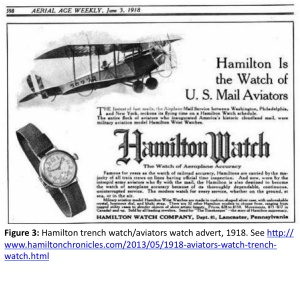 WW1 resulted in a need for a new type of watch, the
WW1 resulted in a need for a new type of watch, the 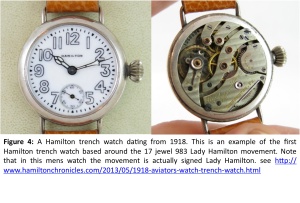 wristwatch or trench watch. Hamilton being a provider of watches for the US military very quickly produced its first trench watch in 1917 (Figure 3 & 4). This watch was based around an 0-sized (1 inch) 17-jewel 983 movement which was initially designed for use in ladies watches (see http://www.hamiltonchronicles.com/2013/05/1918-aviators-watch-trench-watch.html), the movements of these watches were even signed Lady
wristwatch or trench watch. Hamilton being a provider of watches for the US military very quickly produced its first trench watch in 1917 (Figure 3 & 4). This watch was based around an 0-sized (1 inch) 17-jewel 983 movement which was initially designed for use in ladies watches (see http://www.hamiltonchronicles.com/2013/05/1918-aviators-watch-trench-watch.html), the movements of these watches were even signed Lady 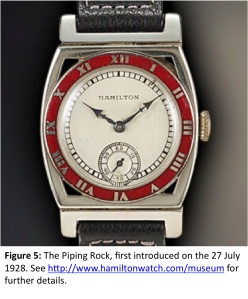 Hamilton. Hamilton produced 6900 of these movements and only about 1500 were cased as trench/aviators watches. They were quickly replaced in 1919 by men’s watches incorporating the O sized 981 calibre or 985 calibre movements. However, it seems that Hamilton couldn’t manufacture these watches fast enough to keep up with demand. The problem lay in the fact that the Hamilton watches were of an extremely high quality and were thus time consuming and expensive to manufacture. It is possible that Hamilton chose to manufacture high-grade wrist watches because to do otherwise could have damaged their brand and their major market, the railroads (see http://www.vintage-hamilton-wristwatches.com/2013/05/when-did-hamilton-make-its-first-gents.html). Hamilton continued to grow in the 1920s, buying the Illinois Watch Company in 1927/28 and as a result of this expanded its range to include numerous lovely Art Deco wrist watches including the stunning and very highly desirable Piping Rock (Figure 5).
Hamilton. Hamilton produced 6900 of these movements and only about 1500 were cased as trench/aviators watches. They were quickly replaced in 1919 by men’s watches incorporating the O sized 981 calibre or 985 calibre movements. However, it seems that Hamilton couldn’t manufacture these watches fast enough to keep up with demand. The problem lay in the fact that the Hamilton watches were of an extremely high quality and were thus time consuming and expensive to manufacture. It is possible that Hamilton chose to manufacture high-grade wrist watches because to do otherwise could have damaged their brand and their major market, the railroads (see http://www.vintage-hamilton-wristwatches.com/2013/05/when-did-hamilton-make-its-first-gents.html). Hamilton continued to grow in the 1920s, buying the Illinois Watch Company in 1927/28 and as a result of this expanded its range to include numerous lovely Art Deco wrist watches including the stunning and very highly desirable Piping Rock (Figure 5).
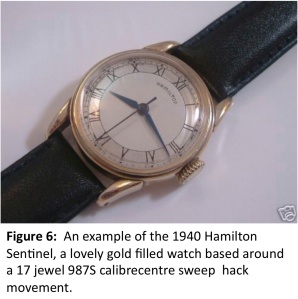 By 1939 WW2 had started in Europe and Hamilton
By 1939 WW2 had started in Europe and Hamilton 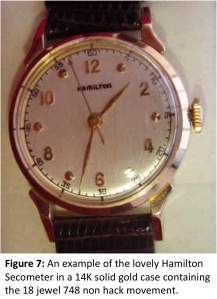 started to produce wristwatches that by modern standards would be more recognisable. Many of these were designed with almost an anticipation of future involvement in conflict. For example in 1940 Hamilton produced its first watch with a central sweep second hand, the Hamilton Sentinel (Figure 6). This watch contained a 17 jewel 987S calibre hack movement, in which the pulling out of the crown to set the watch stopped the second hand.
started to produce wristwatches that by modern standards would be more recognisable. Many of these were designed with almost an anticipation of future involvement in conflict. For example in 1940 Hamilton produced its first watch with a central sweep second hand, the Hamilton Sentinel (Figure 6). This watch contained a 17 jewel 987S calibre hack movement, in which the pulling out of the crown to set the watch stopped the second hand. 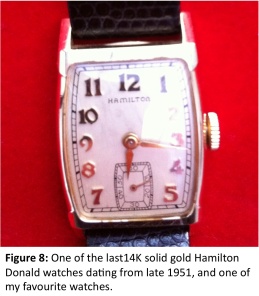 This of course enabled the synchronisation of watches. Talk about reading the market, Hamilton’s timing was perfect. In 1942, following the entry of the USA into WW2, Hamilton ceased producing watches for the civilian market and instead produced a million or more watches for the troops being sent to Europe and the Pacific. These watches were often equipped with movements incorporating the hack mechanism, originally used in the Hamilton Sentinel. After the war many of the designs used in the WW2 military watches were retained in military style dress watches, such as the beautiful 14K solid gold Hamilton Secometer. (Figure 7) The period after the WW2 also saw a return to the manufacture of lovely slim tank watches and Hamilton excelled in the production of some superb watches such as the Hamilton Donald (Figure 8).
This of course enabled the synchronisation of watches. Talk about reading the market, Hamilton’s timing was perfect. In 1942, following the entry of the USA into WW2, Hamilton ceased producing watches for the civilian market and instead produced a million or more watches for the troops being sent to Europe and the Pacific. These watches were often equipped with movements incorporating the hack mechanism, originally used in the Hamilton Sentinel. After the war many of the designs used in the WW2 military watches were retained in military style dress watches, such as the beautiful 14K solid gold Hamilton Secometer. (Figure 7) The period after the WW2 also saw a return to the manufacture of lovely slim tank watches and Hamilton excelled in the production of some superb watches such as the Hamilton Donald (Figure 8).
The post war period witnessed an increasing wealth and the race to produce the first electric watch. Hamilton, apparently in response to rumours that Elgin were working on the development of an electric watch (http://www.electric-watches.co.uk/make/hamilton/index/), started Project X in 1946. This eventually resulted in Hamilton unveiling the worlds first battery powered electric watch, the 14K solid gold Ventura in 1957 and soon after the 14 K yellow and white gold filled Pacer (Figure 9). These watches was something new, the design was striking and had its origins in the emerging space age. These watches were incredibly popular, even Elvis had one. Unfortunately the first Hamilton electric movement, the 500 was a bit unreliable, watch makers were un-used to them and refused to service them, so many were sent back to the manufacturer. Modifications of the 500 led to the development of the much more reliable 505 movement in 1962 and this was manufactured right up until 1969, when Hamilton finally admitted the superiority of Bulova’s Acutron. Despite the unreliability of the Hamilton electric watches they are still highly desirable, although there are only a very few specialist dealers/repairers such as the UK Electric Watch Guru Paul Wirdnam (http://www.electric-watches.co.uk/) who can service and repair them.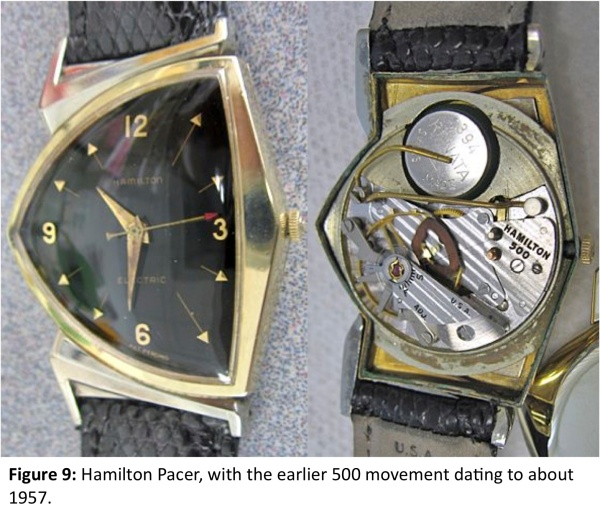
During the Hamilton Electric watch period, Hamilton changed its logo to a stylised H symbolic of the electric watch era (Figure 10). However, Hamilton continued to make very high grade mechanical watches 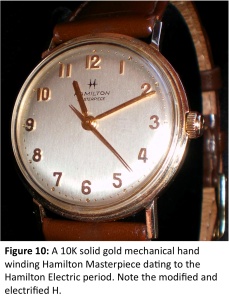 during this period. In 1966 hamilton bought the Buren factory in Switzerland giving rise toHamilton Buren. This allowed Hamilton to incorporate the highly inventive Buren micro rotor blade into its automatic watches. Hamilton stopped making watches in the US in 1969, and shifted their watch making to the Hamilton Buren manufacturing base. By 1972, the Hamilton Buren association had dissolved and Société Suisse pour l’Industrie Horlogère (SSIH – Omega & Tissot) bought the Hamilton brand. Via the merger of SSIH and ASUAG (Allgemeine Schweizerische Uhrenindustrie AG) which gave rise to SMH (Swiss Corporation for Microelectronics and Watchmaking Industries Ltd.) in 1984, Hamilton is now a subsidiary of Swatch. Following the success of the film Men in Black (1990) Hamilton re-launched the Ventura design with a quartz movement. Since then Hamilton has gone on to produce very high quality watches for the luxury market. Hamilton currently sponsors Nicolas Ivanoff (Aerobatic pilot) and his plane the Hamilton branded Edge 540, they host the Hollywood “behind the Camera Awards, and are the official timekeepers of EAA AirVenture and sponsor the annual event at Wittman Regional Airport, Oshkosh, Wisconsin.
during this period. In 1966 hamilton bought the Buren factory in Switzerland giving rise toHamilton Buren. This allowed Hamilton to incorporate the highly inventive Buren micro rotor blade into its automatic watches. Hamilton stopped making watches in the US in 1969, and shifted their watch making to the Hamilton Buren manufacturing base. By 1972, the Hamilton Buren association had dissolved and Société Suisse pour l’Industrie Horlogère (SSIH – Omega & Tissot) bought the Hamilton brand. Via the merger of SSIH and ASUAG (Allgemeine Schweizerische Uhrenindustrie AG) which gave rise to SMH (Swiss Corporation for Microelectronics and Watchmaking Industries Ltd.) in 1984, Hamilton is now a subsidiary of Swatch. Following the success of the film Men in Black (1990) Hamilton re-launched the Ventura design with a quartz movement. Since then Hamilton has gone on to produce very high quality watches for the luxury market. Hamilton currently sponsors Nicolas Ivanoff (Aerobatic pilot) and his plane the Hamilton branded Edge 540, they host the Hollywood “behind the Camera Awards, and are the official timekeepers of EAA AirVenture and sponsor the annual event at Wittman Regional Airport, Oshkosh, Wisconsin.
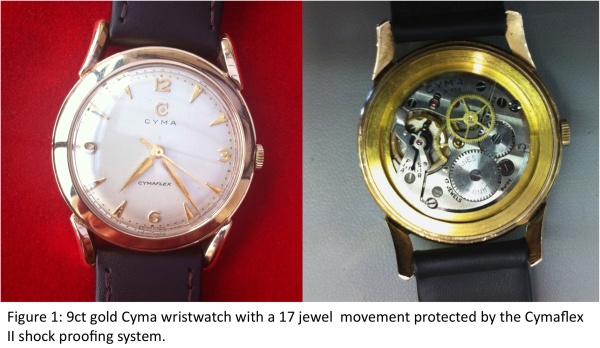 By the late 1960s and early 1970s the watch industry was changing, the advances of Hamilton and Bulovea in the production of electric watches set the scene for the era of the quartz watch. By 1973 Cyma had produced their first electric watch and they were ready to embrace the new technology whilst other watch manufacturers were decimated by it. The brand is currently owned by Stelux International, Ltd and continues to lead in the production of high quality quartz watches. Having achieved this it seems that Cyma has met the goals set out by its founders, after all Cyma now produces watches that are always absolutely accurate.
By the late 1960s and early 1970s the watch industry was changing, the advances of Hamilton and Bulovea in the production of electric watches set the scene for the era of the quartz watch. By 1973 Cyma had produced their first electric watch and they were ready to embrace the new technology whilst other watch manufacturers were decimated by it. The brand is currently owned by Stelux International, Ltd and continues to lead in the production of high quality quartz watches. Having achieved this it seems that Cyma has met the goals set out by its founders, after all Cyma now produces watches that are always absolutely accurate.









